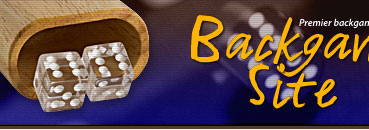How to play backgammon
This article will give you the very basic rules of how to play backgammon.
If you want to learn the more advanced rules, you can look on the other articles on this site,
dealing with - How to play backgammon.
Learning how to play backgammon is very easy, each player rolls a single dice.
This determines both the player to go first. Both players roll again if equal numbers come up,
until they roll different numbers. The highest number moves first. After the first roll,
the players throw both dice and alternate turns. How many points (or pips) a player can
move his stones, is indicated by the roll of the dice. Stones are always moved forward,
to a lower-numbered point. A stone can only be moved to an open point (a point not occupied by
two opposing stones).
The dice and the first moves
The two dice constitute separate moves.
For example, if we want to know how to play backgammon's dice indicating 5 and 3, it is the move
of one stone five spaces and another stone three spaces, the player may also move the one stone
eight spaces to an open point, but only if the intermediate point (either three or five spaces
from the starting point) is open also. A player who rolls doubles plays the numbers twice.
A roll of 6 and 6 means that the player has four sixes, he may move any combination of stones he
wants to complete this move. Player must use all his numbers if legally possible.
When only one number can be played, the player must play that number.
A player must play the higher number If either one can be played, but not both.
A player loses his turn when either number can't be used.
Hitting and Entering
A point occupied by a single stone of either color is called a blot.
If an opposing stone lands on a blot, the blot is hit and placed on the bar.
Anytime a player has one or more stones on the bar, his first obligation is to
enter that stone(s) into the opposing home board by moving it to an open point
corresponding to one of the numbers on the dice. Example; if a player rolls 4 - 6, he may
enter a stone onto either the opponents` four or six point, As long as the point is not
occupied by two or more of the opponents` stones. The player loses his turn if neither of the
points is open. A player must enter as many as he can and then forfeit the remainder of his
turn if he is able to enter only some of his stones. Any unused numbers on the dice must be
played after the last of a player's stones has been entered.
Bearing Off
After a player has moved all of the stones into his home board, he can begin bearing off.
A player bears off a stone, by rolling a number that corresponds to the point on which the stone
resides, and then removing it from the board. If there's no stone on the point, the player move
using a stone on a higher-numbered point. The player can remove a stone from the next highest
point If there are no stones on the higher-numbered points.
If the player knows how to play backgammon, and can make an otherwise legal move,
a player is under no obligation to bear off. A player must have all of his stones in his home board
in order to bear off. If a stone is hit during the bear-off process, the player must bring that
stone back before continuing to bear off.
 Visit GammonEmpire, the most exciting Backgammon action on the internet! Join 24/7 tournaments and matches with players from all around the world. Download is simple and FREE. 12,000+ players are playing online Now!
Visit GammonEmpire, the most exciting Backgammon action on the internet! Join 24/7 tournaments and matches with players from all around the world. Download is simple and FREE. 12,000+ players are playing online Now!
GammonEmpire hosts a $50,000 Backgammon tournament! Entry fee as low as $5!!
- You can join the action here
|
Gammons and Backgammons
If the losing player has borne off at least one stone at the end of the game, he loses only the
value indicated by the doubling cube and the original wager or one point if there has been no doubling.
However, if the loser has not borne off any stones, he is gammoned - losing twice the value of the
doubling cube. If the loser has not borne off his stones and still has a stone in the winners`
home board or on the bar, he is backgammoned and loses three times the value of the cube.
These are the basics this game. Now you can say you know how to play backgammon
but there is still much to learn. After practicing, try our
other backgammon articles dealing with the more
advanced subjects of backgammon.
Want to test your abilities and try what you've learned?
Download the backgammon game for free
from the GammonEmpire site and start playing on the realistic backgammon board.
Play the backgammon game.
Click here!
|


